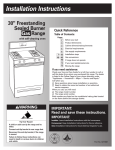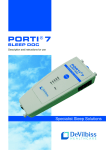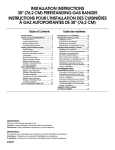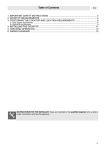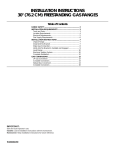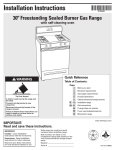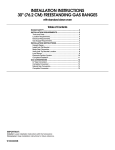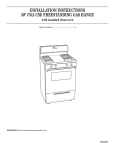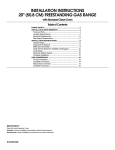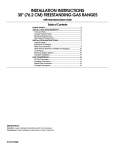Download installation instructions 30" (76 cm) freestanding gas
Transcript
INSTALLATION INSTRUCTIONS 30" (76 CM) FREESTANDING GAS RANGES Table of Contents RANGE SAFETY .............................................................................1 INSTALLATION REQUIREMENTS ................................................2 Tools and Parts ............................................................................2 Location Requirements ................................................................3 Electrical Requirements ...............................................................4 Gas Supply Requirements ...........................................................5 INSTALLATION INSTRUCTIONS ..................................................6 Unpack Range..............................................................................6 Install Anti-Tip Bracket.................................................................6 Verify Anti-Tip Bracket Location ..................................................7 Level Range..................................................................................7 Make Gas Connection..................................................................7 Electronic Ignition System............................................................8 Replace Oven Racks & Storage or Warming Drawer ................10 Complete Installation..................................................................10 GAS CONVERSIONS ....................................................................11 LP Gas Conversion ....................................................................11 Replace Oven Racks & Storage or Warming Drawer ................13 Complete Installation..................................................................13 Natural Gas Conversion .............................................................13 Replace Oven Racks & Storage or Warming Drawer ................14 Complete Installation..................................................................14 ANTI-TIP BRACKET TEMPLATE ................................................16 RANGE SAFETY Your safety and the safety of others are very important. We have provided many important safety messages in this manual and on your appliance. Always read and obey all safety messages. This is the safety alert symbol. This symbol alerts you to potential hazards that can kill or hurt you and others. All safety messages will follow the safety alert symbol and either the word “DANGER” or “WARNING.” These words mean: DANGER WARNING You can be killed or seriously injured if you don't immediately follow instructions. You can be killed or seriously injured if you don't follow instructions. All safety messages will tell you what the potential hazard is, tell you how to reduce the chance of injury, and tell you what can happen if the instructions are not followed. WARNING Tip Over Hazard A child or adult can tip the range and be killed. Connect anti-tip bracket to rear range foot. Reconnect the anti-tip bracket, if the range is moved. Failure to follow these instructions can result in death or serious burns to children and adults. IMPORTANT: Installer: Leave installation instructions with the homeowner. Homeowner: Keep installation instructions for future reference. Save installation instructions for local electrical inspector's use. 9758657 WARNING: For your safety, the information in this manual must be followed to minimize the risk of fire or explosion, or to prevent property damage, personal injury, or death. – Do not store or use gasoline or other flammable vapors and liquids in the vicinity of this or any other appliance. – WHAT TO DO IF YOU SMELL GAS: • Do not try to light any appliance. • Do not touch any electrical switch; do not use any phone in your building. • Clear the room, building, or area of all occupants. • Immediately call your gas supplier from a neighbor's phone. Follow the gas supplier's instructions. • If you cannot reach your gas supplier, call the fire department. – Installation and service must be performed by a qualified installer, service agency, or the gas supplier. In the State of Massachusetts, the following installation instructions apply: ■ ■ ■ Installations and repairs must be performed by a qualified or licensed contractor, plumber, or gasfitter qualified or licensed by the State of Massachusetts. If using a ball valve, it shall be a T-handle type. A flexible gas connector, when used, must not exceed 3 feet. INSTALLATION REQUIREMENTS Tools and Parts Gather the required tools and parts before starting installation. Read and follow the safety instructions provided with any tools listed here. Parts supplied Check that all parts are included. A Tools needed ■ Tape measure ■ Marker or pencil ■ Flat-blade screwdriver ■ Masking tape ■ Phillips screwdriver ■ ■ Level Pipe-joint compound resistant to LP gas ■ Hand or electric drill ■ ■ Hammer ³⁄₁₆" (4.8 mm) carbide-tipped masonry drill bit (for concrete/ceramic floors) ■ Channel lock pliers ■ Pipe wrench ■ ¹⁵⁄₁₆" combination wrench ■ ³⁄₈" drive ratchet For LP/Natural Gas Conversions ■ ½" combination wrench ■ ³⁄₈" nut driver ■ ⁵⁄₈” combination wrench ■ ¹⁄₈" (3.2 mm) drill bit (for wood floors) ■ ⁵⁄₁₆” nut driver Parts needed ■ Quadrex or Phillips screwdriver Check local codes and consult gas supplier. Check existing gas supply and electrical supply. See “Electrical Requirements” and “Gas Supply Requirements” sections. 2 ■ B C A. Anti-tip bracket B. Plastic anchors (2) C. #10 x ¹⁄₂" screws (2) Noncorrosive leak-detection solution ■ Brackets must be securely mounted to subfloor. Thickness of flooring may require longer screws to anchor bracket to subfloor. Longer screws are available from your local hardware store. Location Requirements IMPORTANT: Observe all governing codes and ordinances. Do not obstruct flow of combustion and ventilation air. ■ It is the installer’s responsibility to comply with installation clearances specified on the model/serial rating plate. The model/serial rating plate is located on the oven frame behind the storage drawer panel. ■ The range should be located for convenient use in the kitchen. ■ Recessed installations must provide complete enclosure of the sides and rear of the range. ■ To eliminate the risk of burns or fire by reaching over heated surface units, cabinet storage space located above the surface units should be avoided. If cabinet storage is to be provided, the risk can be reduced by installing a range hood that projects horizontally a minimum of 5" (12.7 cm) beyond the bottom of the cabinets. ■ All openings in the wall or floor where range is to be installed must be sealed. ■ Do not seal the range to the side cabinets. ■ Cabinet opening dimensions that are shown must be used. Given dimensions are minimum clearances. ■ The floor anti-tip bracket must be installed. To install the antitip bracket shipped with the range, see “Install Anti-Tip Bracket” section. ■ Grounded electrical supply is required. See “Electrical Requirements” section. Proper gas supply connection must be available. See “Gas Supply Requirements” section. ■ Contact a qualified floor covering installer to check that the floor covering can withstand at least 200°F (93°C). ■ Use an insulated pad or ¼" (0.64 cm) plywood under range if installing range over carpeting. IMPORTANT: Some cabinet and building materials are not designed to withstand the heat produced by the oven for baking and self-cleaning. Check with your builder or cabinet supplier to make sure that the materials used will not discolor, delaminate or sustain other damage. Product Dimensions A B C E D A. 27¹⁄₈" (68.9 cm) depth with handle B. 36" (91.4 cm) cooktop height C. 46⁷⁄₈" (119.1 cm) overall height D. 29⁷⁄₈" (75.9 cm) width E. 25" (63.5 cm) Mobile Home - Additional Installation Requirements The installation of this range must conform to the Manufactured Home Construction and Safety Standard, Title 24 CFR, Part 3280 (formerly the Federal Standard for Mobile Home Construction and Safety, Title 24, HUD Part 280). When such standard is not applicable, use the Standard for Manufactured Home Installations, ANSI A225.1/NFPA 501A or with local codes. Mobile home installations require: ■ When this range is installed in a mobile home, it must be secured to the floor during transit. Any method of securing the range is adequate as long as it conforms to the standards listed above. 3 Installation Clearances Electrical Requirements Cabinet opening dimensions shown are for 25" (64 cm) countertop depth, 24" (61 cm), base cabinet depth and 36" (91.4 cm) countertop height. If the cabinet depth is greater than 24" (61 cm) oven frame must extend beyond cabinet fronts by ½" (13 mm) minimum. WARNING D B Electrical Shock Hazard C Plug into a grounded 3 prong outlet. Do not remove ground prong. Do not use an adapter. A E Do not use an extension cord. Failure to follow these instructions can result in death, fire, or electrical shock. K G G H F I J I A. 18" (45.7 cm) upper side cabinet to countertop B. 13" (33 cm) max. upper cabinet depth C. 30" (76.2 cm) min. opening width D. For minimum clearance to top of cooktop, see NOTE* E. 30¹⁄₈" (76.5 cm) min. opening width F. This shaded area recommended for installation of rigid gas pipe G. 8" (20.3 cm) H. 17" (43.2 cm) I. 4¹⁄₂" (11.4 cm) J. 2" (5.1 cm) K. 2" (5.0 cm) min. clearance from both sides of range to side wall or other combustible material. *NOTE: 24" (61 cm) minimum when bottom of wood or metal cabinet is protected by not less than ¹⁄₄" (0.64 cm) flame retardant millboard covered with not less than No. 28 MSG sheet steel, 0.015" (0.4 mm) stainless steel, 0.024" (0.6 mm) aluminum or 0.020" (0.5 mm) copper. 30" (76.2 cm) minimum clearance between the top of the cooking platform and the bottom of an unprotected wood or metal cabinet. 4 IMPORTANT: The range must be electrically grounded in accordance with local codes and ordinances, or in the absence of local codes, with the National Electrical Code, ANSI/NFPA 70 or Canadian Electrical Code, CSA C22.1 This range is equipped with an electronic ignition system that will not operate if plugged into an outlet that is not properly polarized. If codes permit and a separate ground wire is used, it is recommended that a qualified electrical installer determine that the ground path is adequate. A copy of the above code standards can be obtained from: National Fire Protection Association One Batterymarch Park, Quincy, MA 02269. CSA International 8501 East Pleasant Valley Road Cleveland, OH 44131-5575 ■ A 120 volt, 60 Hz., AC only, 15-amp fused, electrical circuit is required. A time-delay fuse or circuit breaker is also recommended. It is recommended that a separate circuit serving only this range be provided. ■ Electronic ignition systems operate within wide voltage limits, but proper grounding and polarity are necessary. Check that the outlet provides 120-volt power and is correctly grounded. ■ The wiring diagram is located on the back of the range in a clear plastic bag. NOTE: The metal chassis of the range must be grounded in order for the control panel to work. If the metal chassis of the range is not grounded, no keypads will operate. Check with a qualified electrician if you are in doubt as to whether the metal chassis of the range is grounded. Gas Supply Requirements Flexible metal appliance connector: WARNING ■ If local codes permit, a new C.S.A. design-certified, 4 - 5 ft (122 - 152.4 cm) long, ½" (1.3 cm) or ¾" (1.9 cm) I.D., flexible metal appliance connector may be used for connecting range to the gas supply line. Explosion Hazard ■ A ½" (1.3 cm) male pipe thread is needed for connection to the female pipe threads of the inlet to the appliance pressure regulator. ■ Do not kink or damage the flexible metal tubing when moving the range. Use a new CSA International approved gas supply line. Install a shut-off valve. Securely tighten all gas connections. Rigid pipe connection: If connected to LP, have a qualified person make sure gas pressure does not exceed 14" (36 cm) water column. The rigid pipe connection requires a combination of pipe fittings to obtain an in-line connection to the range. The rigid pipe must be level with the range connection. All strains must be removed from the supply and fuel lines so range will be level and in line. Examples of a qualified person include: licensed heating personnel, authorized gas company personnel, and authorized service personnel. Failure to do so can result in death, explosion, or fire. Observe all governing codes and ordinances. IMPORTANT: This installation must conform with all local codes and ordinances. In the absence of local codes, installation must conform with American National Standard, National Fuel Gas Code ANSI Z223.1 - latest edition or CAN/CGA B149 - latest edition. Type of Gas Natural Gas: This range is design-certified by CSA International for use with Natural gas or, after proper conversion, for use with LP gas. ■ This range is factory set for use with Natural gas. See “Gas Conversions” section. The model/serial rating plate located on the frame behind the storage drawer has information on the types of gas that can be used. If the types of gas listed do not include the type of gas available, check with the local gas supplier. LP Gas conversion: Conversion must be done by a qualified service technician. No attempt shall be made to convert the appliance from the gas specified on the model/serial rating plate for use with a different gas without consulting the serving gas supplier. See “Gas Conversions” section. Gas Supply Line ■ Provide a gas supply line of ¾" (1.9 cm) rigid pipe to the range location. A smaller size pipe on longer runs may result in insufficient gas supply. Pipe-joint compounds that resist the action of LP gas must be used. Do not use TEFLON®† tape. With LP gas, piping or tubing size can be ½" (1.3 cm) minimum. Usually, LP gas suppliers determine the size and materials used in the system. ■ Must include a shutoff valve: The supply line must be equipped with a manual shutoff valve. This valve should be located in the same room but external to the range. It should be in a location that allows ease of opening and closing. Do not block access to shutoff valve. The valve is for turning on or shutting off gas to the range. B A C A. Gas supply line B. Shutoff valve “open” position C. To range Gas Pressure Regulator The gas pressure regulator supplied with this range must be used. The inlet pressure to the regulator should be as follows for proper operation: Natural Gas: Minimum pressure: 6" WCP Maximum pressure: 14" WCP LP Gas: Minimum pressure: 11" WCP Maximum pressure: 14" WCP Contact local gas supplier if you are not sure about the inlet pressure. †®TEFLON is a registered trademark of E.I. Du Pont De Nemours and Company. 5 Burner Input Requirements Gas Supply Pressure Testing Input ratings shown on the model/serial rating plate are for elevations up to 2,000 ft (609.6 m). For elevations above 2,000 ft (609.6 m), ratings are reduced at a rate of 4% for each 1,000 ft (304.8 m) above sea level (not applicable for Canada). Line pressure testing above ½ psi gauge (14" WCP) The range and its individual manual shutoff valve must be disconnected from the gas supply piping system during any pressure testing of that system at test pressures greater than ½ psi (3.5 kPa). Line pressure testing at ½ psi gauge (14" WCP) or lower The range must be isolated from the gas supply piping system by closing its individual manual shutoff valve during any pressure testing of that system at test pressures equal to or less than ½ psi (3.5 kPa). INSTALLATION INSTRUCTIONS Unpack Range WARNING Excessive Weight Hazard Use two or more people to move and install range. Failure to do so can result in back or other injury. 1. Remove shipping materials, tape and protective film from range. Keep cardboard bottom under range. Remove oven racks and parts package from inside oven. 2. Take 4 cardboard corners from the carton. Stack one cardboard corner on top of another. Repeat with the other 2 corners. Place them lengthwise on the floor behind the range to support the range when it is laid on its back. Using 2 or more people, firmly grasp the range and gently lay it on its back on the cardboard corners. 3. Pull cardboard bottom firmly to remove. 4. Use an adjustable wrench to loosen the leveling legs. 5. Place cardboard or hardboard in front of range. Using 2 or more people, stand range back up onto cardboard or hardboard. Install Anti-Tip Bracket Before moving range, slide range onto shipping base, cardboard or hardboard. 1. Remove template from the anti-tip bracket kit (found inside the oven cavity) or from the back page of this manual. 2. Place template on the floor in cabinet opening so that the left edge is against cabinet and top edge is against rear wall, molding or cabinet. 3. Tape template into place. 4. If countertop is not flush with cabinet opening edge, align template with overhang. If cabinet opening is wider than specified in the “Location Requirements” section, adjust template so range will be centered in cabinet opening. 5. To mount anti-tip bracket to wood floor, drill two ¹⁄₈" (3.2 mm) holes at the positions marked on the bracket template. Remove template from floor. WARNING Tip Over Hazard A child or adult can tip the range and be killed. Connect anti-tip bracket to rear range foot. Reconnect the anti-tip bracket, if the range is moved. Failure to follow these instructions can result in death or serious burns to children and adults. Contact a qualified floor covering installer for the best procedure for drilling mounting holes through your type of floor covering. 6 To mount anti-tip bracket to concrete or ceramic floor, use a ³⁄₁₆" (4.8 mm) masonry drill bit to drill 2 holes at the positions marked on the bracket template. Remove template from floor. 6. Tap plastic anchors into holes with a hammer. 7. Align anti-tip bracket holes with holes in floor. Fasten anti-tip bracket with screws provided. ■ Slide range back so rear range foot is under anti-tip bracket. 5. If installing the range in a mobile home, you must secure the range to the floor. Any method of securing the range is adequate as long as it conforms to the standards in the “Location Requirements” section. Depending on the thickness of your flooring, longer screws may be necessary to anchor the bracket to the subfloor. Longer screws are available from your local hardware store. 8. Move range close to opening. Remove shipping base, cardboard or hardboard from under range. 9. Connect power supply cord as described in the “Electrical Connection” section. 10. Move range into final position making sure rear leveling leg slides into anti-tip bracket. 11. Continue installing your range using the following the installation instructions. Verify Anti-Tip Bracket Location WARNING Excessive Weight Hazard Use two or more people to move and install range. Failure to do so can result in back or other injury. 1. Move range close to cabinet opening. 2. Remove cardboard or hardboard from under range. Gently move range into its final position. 3. Pull drawer open to first stop position. Lift front of drawer to clear white wheels in drawer guides. Remove drawer and set it aside on a protected surface. See the Use and Care Guide for the model drawer removal. Level Range Place rack in oven. Place level on rack, first side to side; then front to back. If range is not level, pull range forward until rear leveling leg is removed from the anti-tip bracket. Use ³⁄₈" drive ratchet and channel lock pliers to adjust leveling legs up or down until range is level. Push range back into position. Check that rear leveling leg is engaged in anti-tip bracket. NOTE: Oven must be level for satisfactory baking performance. Make Gas Connection Typical rigid pipe connection A combination of pipe fittings must be used to connect the range to the existing gas line. Your connections may be different, according to the supply line type, size and location. 1. Apply pipe-joint compound made for use with LP gas to all pipe thread connections. 2. Using a pipe wrench to tighten, connect the gas supply to the range. B C D A F E J I 4. Making sure the anti-tip bracket is installed: ■ Look for the anti-tip bracket securely attached to floor. A. Gas pressure regulator B. 90° elbow (must have ½" male pipe thread) C. Nipple D. Union E. Black iron pipe H G F. Manual gas shutoff valve G. ½" or ¾" gas pipe H. Nipple I. Union J. 90° elbow 7 Typical flexible connection 1. Apply pipe-joint compound made for use with LP gas to the smaller thread ends of the flexible connector adapters (see B and G in following illustration). 2. Attach one adapter to the gas pressure regulator and the other adapter to the gas shutoff valve. Tighten both adapters. 3. Use a ¹⁵⁄₁₆" combination wrench and channel lock pliers to attach the flexible connector to the adapters. Check that connector is not kinked. A B C C B A A. Burner base B. Burner cap C. Burner grate D E WARNING H A. Gas pressure regulator B. Use pipe-joint compound C. Adapter (must have ½" male pipe thread) D. Flexible connector G F E. Manual gas shutoff valve F. ½" or ¾" gas pipe G. Use pipe-joint compound H. Adapter Electrical Shock Hazard Plug into a grounded 3 prong outlet. Complete Connection Do not remove ground prong. 1. Check that the gas pressure regulator shutoff valve is in the “on” position. Do not use an adapter. Do not use an extension cord. Failure to follow these instructions can result in death, fire, or electrical shock. A A. Gas pressure regulator shutoff valve 5. Plug into a grounded 3 prong outlet. Electronic Ignition System 2. Open the manual shutoff valve in the gas supply line. The valve is open when the handle is parallel to the gas pipe. Initial lighting and gas flame adjustments A B A. Closed valve B. Open valve 3. Test all connections by brushing on an approved noncorrosive leak-detection solution. Bubbles will show a leak. Correct any leak found. 4. Remove cooktop burner caps and grates from parts package. Burner caps should be level when properly positioned. If burner caps are not properly positioned, surface burners will not light. Place burner grates over burners and caps. Cooktop and oven burners use electronic igniters in place of standing pilots. When the cooktop control knob is turned to the “LITE” position, the system creates a spark to light the burner. This sparking continues, as long as the control knob is turned to “LITE.” When the oven control is turned to the desired setting, sparking occurs and ignites the gas. Check Operation of Cooktop Burners Standard Surface Burners Push in and turn each control knob to the “LITE” position. The flame should light within 4 seconds. The first time a burner is lighted it may take longer that 4 seconds to light because of air in the gas line. If burners do not light properly: ■ Turn cooktop control knob to the “OFF” position. ■ Check that the range is plugged in and the circuit breaker has not tripped or the fuse blown. ■ Check that the gas shutoff valves are set to the “open” position. ■ Check that burner caps are properly positioned on burner bases. Repeat start-up. If a burner does not light at this point, contact your dealer or authorized service company for assistance. 8 Adjust Flame Height Adjust the height of top burner flames. The cooktop “low” burner flame should be a steady blue flame approximately ¼" (0.64 cm) high. 3. You can check the burner flame by removing the flame spreader or by using a mirror. Remove flame spreader: Remove 2 screws from the front tabs of the flame spreader. Lift front of the flame spreader and pull forward to remove tabs from rear of oven. Using a mirror: Insert a mirror to one side of the burner. Look into the mirror to check flame. A A B B C A. Low flame B. High flame If the ‘low” flame needs to be adjusted: The flame can be adjusted using the adjustment screw in the center of the valve stem. The valve stem is located directly underneath the control knob. A B A. Control knob stem B. Screwdriver 1. Remove the control knob. 2. Hold the knob stem with a pair of pliers. Use a small flatblade screwdriver to turn the screw located in the center of the control knob stem until the flame is the proper size. 3. Replace the control knob. 4. Test the flame by turning the control from “LO” to “HI,” checking the flame at each setting. Check Operation of Oven Bake Burner 1. Remove the oven rack. 2. To remove the oven bottom: Remove 2 screws at the rear of the oven bottom. Lift the rear of the oven bottom up and back until the front of the panel is away from the front frame. Remove from oven and place the cover on a protected surface. A D A. Mirror B. Flame spreader C. Flame reflection D. 2 screws 4. Push the BAKE pad. 5. Press the START pad. The oven bake burner should light within 8 seconds, under certain conditions it may take the burner up to 50 to 60 seconds to light. Electronic igniters are used to light the bake and broil burners. Refer to the Use and Care Guide for proper operation of the oven controls. Adjust Oven Bake Burner Flame (if needed) 1. On models with a warming drawer, remove access cover plate (1 screw) located at the back of the warming drawer compartment. 2. Check the oven bake burner for proper flame. This flame should have a ½" (1.3 cm) long inner cone of bluish-green, with an outer mantle of dark blue, and should be clean and soft in character. No yellow tips, blowing or lifting of flame should occur. 3. If the oven bake flame needs to be adjusted, locate the air shutter near the center rear of the range. Loosen the locking screw and rotate the air shutter until the proper flame appears. Tighten locking screw. B A A. Air shutter B. Locking screw A. Screws 4. Push CANCEL/OFF pad. 5. Reinstall flame spreader and oven bake burner cover. 9 Check Operation of Oven Broil Burner 1. Close the oven door. 2. Press the BROIL pad. 3. Press the START pad. The oven burner should light within 8 seconds; under certain conditions it may take the burner up to 50 to 60 seconds to light. Refer to the Use and Care Guide for proper operation of the oven controls. Adjust Oven Broil Burner Flame (if needed) Look through oven window to check broil burner for proper flame. This flame should have a ½" (1.3 cm) long inner cone of bluish-green, with an outer mantle of dark blue, and should be clean and soft in character. No yellow tips, blowing or lifting of flame should occur. If flame needs to be adjusted: 1. Loosen the lock screw on the air shutter located at the rear of the broil burner. 2. Adjust the air shutter as need. 3. Tighten lock screw. Replace Oven Racks & Storage or Warming Drawer Replace oven racks in oven cavity. Insert storage drawer or warming drawer into slide rails on sides of drawer opening. Lift front of drawer slightly and push firmly to close drawer. Complete Installation 1. Check to be sure all parts are now installed. If there is an extra part, go back through the steps to see which step was skipped. 2. Check to be sure you have all of your tools. 3. Dispose of/recycle all packaging materials. 4. Check to be sure the range is level. See “Level Range.” 5. Use a mild solution of liquid household cleaner and warm water to remove waxy residue caused by protective shipping material. Dry thoroughly with a soft cloth. For more information, see the “Range Care” section of the Use and Care Guide. 6. Read “Range Use” in the Use and Care Guide. 7. Plug into a grounded 3 pronge outlet. 8. Turn on surface burners and oven. See the Use and Care Guide for specific instruction on range operation. If range does not operate, check the following: ■ Household fuse is intact and tight; or circuit breaker has not tripped. ■ Range is plugged into a grounded 3 prong outlet. ■ Electrical supply is connected. ■ See “Troubleshooting” in the Use and Care Guide. 9. When the range has been on for 5 minutes, feel for heat. If you do not feel heat, turn the range off and check to see that the gas supply line shutoff valve is open. ■ If the gas supply line shutoff valve is closed, open it, then repeat the 5-minute test as outlined above. A ■ A. Lock screw 10 If the gas supply line shutoff valve is open, contact a qualified technician. GAS CONVERSIONS WARNING 2. Remove storage drawer or warming drawer. Locate gas pressure regulator at rear of storage or warming drawer compartment. NOTE: On models with a warming drawer, an access cover must be removed from the gas pressure regulator. A Explosion Hazard Use a new CSA International approved gas supply line. Install a shut-off valve. Securely tighten all gas connections. A. Gas pressure regulator If connected to LP, have a qualified person make sure gas pressure does not exceed 14" (36 cm) water column. Examples of a qualified person include: licensed heating personnel, authorized gas company personnel, and authorized service personnel. Failure to do so can result in death, explosion, or fire. IMPORTANT: Do not remove the gas pressure regulator. Gas pressure regulator 3. Remove plastic cover from gas pressure regulator cap. 4. Turn gas pressure regulator cap counterclockwise with a ⁵⁄₈" combination wrench to remove. NOTE: Do not remove the spring beneath the cap. Side view before A LP Gas Conversion NG WARNING D E NG B LP A child or adult can tip the range and be killed. Connect anti-tip bracket to rear range foot. Reconnect the anti-tip bracket, if the range is moved. Failure to follow these instructions can result in death or serious burns to children and adults. C Side view after LP Tip Over Hazard A. Plastic cover B. Gas pressure regulator cap with solid end facing out C. Gas pressure regulator cap with hollow end facing out D. Washer E. Gas pressure regulator cap 5. Turn over the gas pressure regulator cap and reinstall on regulator so that the hollow end faces out and the marking “<- LP” is facing the direction shown in the above drawing. 6. Replace plastic cover over gas pressure regulator cap. To Convert Gas Pressure Regulator 1. Ensure that the manual shutoff valve is in the closed position and the power supply cord is unplugged. B A C A. To range B. Manual shutoff valve “closed” position C. Gas supply line To Convert Standard Surface Burners 1. Remove burner cap. 2. Using a Quadrex or Phillips screwdriver, remove the burner base. NOTE: Reinstall one of the screws through the range cooktop to hold the orifice spud holder in place while removing and replacing the orifice spuds. 11 3. Apply masking tape to the end of a ⁵⁄₁₆" nut driver to help hold the gas orifice spud in the nut driver while changing it. Press nut driver down onto the gas orifice spud and remove by turning it counterclockwise and lifting out. Set gas orifice spud aside. C A To Convert Oven Bake Burner 1. Remove oven racks. 2. Use a ½" combination wrench to turn the orifice hood down snug onto pin (about 2 to 2½ turns). IMPORTANT: Do not overtighten. The oven bake burner flame cannot be properly adjusted if this conversion is not made. See “Adjust Oven Bake Burner Flame” section. D B B A. Orifice spud B. Orifice spud holder C. Screw D. Spark electrode D C A 4. Remove the cardboard orifice spud holder located on the back of the range near the gas inlet. Gas orifice spuds are stamped with a number, marked with 1 color dot, and have a groove in the hex area. Replace the Natural gas orifice spud with the correct LP gas orifice spud. A. Orifice hood B. Pin C. Natural gas: increase gas - increase flame size (preset at factory for Natural gas) D. LP gas: decrease gas - decrease flame size To Convert Oven Broil Burner A A. Groove Refer to the following chart for correct LP gas orifice spud placement. Use a ½" combination wrench to turn the orifice hood down snug onto the pin (about 2 to 2½ turns). IMPORTANT: Do not overtighten. The oven broil burner flame cannot be properly adjusted if this conversion is not made. See “Adjust Oven Broil Burner Flame” section. LP Gas Orifice Spud Chart for Standard Surface Burners Burner Rating Color Size ID Number 12,000 BTU 11,000 BTU 8,000 BTU 5,000 BTU Green/Magenta Green/Yellow Green/Lt. Blue Green/Brown 1.03 mm 0.99 mm 0.80 mm 0.65 mm L103 L99 L80 L65 NOTE: Refer to the Model Number and Serial Number Plate located behind the left side of the storage or warming drawer for proper sizing of spuds for each burner location. 5. Place Natural gas orifice spuds in the cardboard orifice spud holder. 6. Replace the burner base using both screw. 7. Replace burner cap. 8. Repeat steps 1-7 for the remaining burners. 12 A A A. Orifice hood Replace Oven Racks & Storage or Warming Drawer Replace oven racks in oven cavity. Insert storage drawer or warming drawer into slide rails on sides of drawer opening. Lift front of drawer slightly and push firmly to close drawer. 2. Remove storage drawer or warming drawer. Locate gas pressure regulator at rear of storage or warming drawer compartment. NOTE: On models with a warming drawer, an access cover must be removed from the gas pressure regulator. A Complete Installation 1. Refer to the “Make Gas Connection” section for properly connecting the range to the gas supply. 2. Refer to the “Electronic Ignition System” section for proper burner ignition, operation, and burner flame adjustments. IMPORTANT: You may have to adjust the “LO” setting for each cooktop burner. Checking for proper cooktop, bake and broil burner flame is very important. The small inner cone should have a very distinct blue flame ¼" (0.64 cm) to ½" (1.3 cm) long. The outer cone is not as distinct as the inner cone. LP gas flames have a slightly yellow tip. 3. Refer to “Complete Installation” in the “Installation Instructions” section of this manual to complete this procedure. Natural Gas Conversion A. Gas pressure regulator IMPORTANT: Do not remove the gas pressure regulator. Gas pressure regulator 3. Remove plastic cover from gas pressure regulator cap. 4. Turn gas pressure regulator cap counterclockwise with a ⁵⁄₈" combination wrench to remove. NOTE: Do not remove the spring beneath the cap. Side view before A LP WARNING D LP B E NG Tip Over Hazard C Side view after NG A child or adult can tip the range and be killed. Connect anti-tip bracket to rear range foot. Reconnect the anti-tip bracket, if the range is moved. Failure to follow these instructions can result in death or serious burns to children and adults. To Convert Gas Pressure Regulator 1. Ensure that the main shutoff valve is in the closed position and the power supply cord is unplugged. B A C A. To range B. Manual shutoff valve “closed” position C. Gas supply line A. Plastic cover B. Gas pressure regulator cap with hollow end facing out C. Gas pressure regulator cap with solid end facing out D. Washer E. Gas pressure regulator cap 5. Turn over the gas pressure regulator cap and reinstall on regulator so that the solid end faces out and the marking “<- N” is facing the direction shown in the above drawing. 6. Replace plastic cover over gas pressure regulator cap. To Convert Standard Surface Burners 1. Remove burner cap. 2. Using a Quadrex or Phillips screwdriver, remove the burner base. NOTE: Reinstall one of the screws through the range cooktop to hold the orifice spud holder in place while removing and replacing the orifice spuds. 13 3. Apply masking tape to the end of a ⁵⁄₁₆" nut driver to help hold the gas orifice spud in the nut driver while changing it. Press nut driver down onto the gas orifice spud and remove by turning it counterclockwise and lifting out. Set gas orifice spud aside. B C A D C A D A A. Orifice hood B. Pin C. Natural gas: increase gas - increase flame size (preset at factory for Natural gas). D. LP gas: decrease gas - decrease flame size B A. Orifice spud B. Orifice spud holder C. Screw D. Spark electrode To Convert Oven Broil Burner XXX 4. Gas orifice spuds are stamped with a number on the side. Replace the LP gas orifice spud with the correct Natural gas orifice spud. Use a ½" combination wrench to loosen the orifice hood away from the pin (about 2 to 2½ turns). The oven broil burner flame cannot be properly adjusted if this conversion is not made. See “Adjust Oven Broil Burner Flame” section. A A. Stamped number Refer to the following chart for the correct Natural gas orifice spud placement. Natural Gas Orifice Spud Chart for Standard Surface Burners Burner Rating Color Size ID Number 13,500 BTU 12,000/12,500 BTU 9,500 BTU 8,000 BTU 5,000 BTU Blue/Orange Blue/Red Blue/Brass Blue/Black Blue/White 1.86 mm 1.76 mm 1.51 mm 1.39 mm 1.12 mm N186 N176 N151 N139 N112 NOTE: Refer to the Model Number and Serial Number Plate located behind the left side of the storage or warming drawer for proper sizing of spuds for each burner location. 5. Place LP gas orifice spuds in plastic parts bag for future use and keep with literature package. 6. Replace the burner base using both screws. 7. Replace burner cap. 8. Repeat steps 1-7 for the remaining burners. To Convert Oven Bake Burner 1. Remove oven racks. 2. Use a ½" combination wrench to loosen the orifice hood away from the pin (about 2 to 2½ turns). The oven bake burner flame cannot be properly adjusted if this conversion is not made. See “Adjust Oven Bake Burner Flame” section. 14 A A. Orifice hood Replace Oven Racks & Storage or Warming Drawer Replace oven racks in oven cavity. Insert storage drawer or warming drawer into slide rails on sides of drawer opening. Lift front of drawer slightly and push firmly to close drawer. Complete Installation 1. Refer to the “Make Gas Connection” section for properly connecting the range to the gas supply. 2. Refer to the “Electronic Ignition System” section for proper burner ignition, operation, and burner flame adjustments. IMPORTANT: You may have to adjust the “LO” setting for each cooktop burner. Checking for proper cooktop, bake and broil burner flame is very important. Natural gas flames do not have yellow tips. 3. Refer to “Complete Installation” in the “Installation Instructions” section of this manual to complete this procedure. Notes 15 ANTI-TIP BRACKET TEMPLATE Cut on dotted lines and place the left edge against the left side cabinet and the top edge against the rear wall. Left edge Top edge 9758657 © 2005. All rights reserved. 3/05 Printed in U.S.A.
















